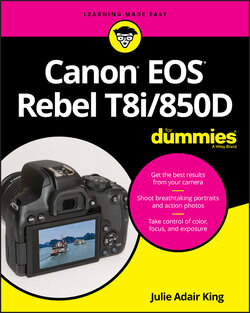Читать книгу Canon EOS Rebel T8i/850D For Dummies - King Julie Adair, Julie Adair King - Страница 19
Mastering menu basics
ОглавлениеHere’s how to display menus and adjust the options on those menus:
Opening and closing menus: Press the Menu button (upper-left corner on the back of the camera) to display menus; press it again to exit the menu system and return to shooting. You also can just press the shutter button halfway and release it to exit to shooting mode.
Understanding menu screens: Which menus and menu screens appear depends on the exposure mode, which you set by rotating the Mode dial on top of the camera. Things also change when you switch from still photography to Movie mode, which you accomplish by moving the On/Off switch to the movie-camera symbol. Figure 1-18 shows a menu screen as it appears for normal photography in the advanced exposure modes (P, Tv, Av, and M).FIGURE 1-18: You can access all menus only when the Mode dial is set to P, Tv, Av, or M.However, the following menu elements are common to all exposure modes:Menu icons: Icons along the top of the screen represent individual menus. In the advanced exposure modes, you get the six menus labeled in Figure 1-18: Shooting, Playback, Network, Setup, Display Level Settings, and My Menu. The My Menu feature, which enables you to build a custom menu, isn’t available in other exposure modes.Menu page numbers: Some menus are multi-page affairs. The numbers under the menu icons represent the various pages of the current menu. The Shooting menu offers five pages, as shown in the figure. This book takes the same approach to menu-page references as the Canon instruction manual: Shooting Menu 1 refers to page one of the Shooting menu, Shooting Menu 2 to page two, and so on. How many pages appear for each menu depends, again, on the exposure mode and whether the camera is set to still photography or Movie mode.The highlighted menu icon marks the active menu; options on that menu appear automatically on the main part of the screen. In Figure 1-18, Shooting Menu 1 is active.
Selecting a menu or menu page: You have these options:Touchscreen: Tap the menu icon to select that menu; tap a page number to display that page.Quick Control dial or Main dial: Press the right or left edge of the Quick Control dial or rotate the Main dial to scroll through the menu icons. With either technique, you have to scroll through all pages of a menu to get to the neighboring menu. As you scroll through the menus, notice the color coding: red for the Shooting menu, blue for the Playback menu, purple for the Network menu, orangey-yellow (ochre?) for the Setup menu, teal for Display Level Settings, and green for My Menu.
Select and adjust a menu setting: Again, you have a choice of techniques:Touchscreen: Tap the menu item to display options for that setting. The current setting is highlighted; tap another setting to select it. On some screens, you see a Set icon; if it appears, tap that icon to lock in your selection and exit the settings screen.Quick Control dial and Set button: Press the top or bottom edge of the Quick Control dial to highlight the menu option and then press the Set button to display the available options for that setting. Press the edges of the Quick Control dial up, down, right, or left as needed to scroll to the setting you want to select. Then press the Set button to lock in your choice. You can mix and match techniques, by the way. For example, even if you access a menu option via the Quick Control dial, you can use the touchscreen to select a setting.
Instructions from this point forward assume you don’t need to be told the specifics of how to select menus and menu options at every turn. So instead of stepping you through each button press or touchscreen tap required to adjust a setting, instructions simply say something like “Choose Image Quality from Shooting Menu 1.” If choosing a menu option involves any special steps, however, I provide guidance.
